| Srl | Item |
| 1 |
ID:
155019
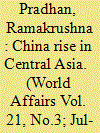

|
|
|
|
|
| Summary/Abstract |
The fight for hegemony in Central Asia is age old and the new Belt and Road Initiative has dramatically underscored the region’s strategic value to the West and opened up a bonanza for Chinese economic, political and security interests. Ramakrushna Pradhan analyses China’s emergence and interests in Central Asia and the implications for future developments in the region. He also explores the possibility of the Belt and Road Initiative becoming the new lever of the balance of power in Eurasia.
|
|
|
|
|
|
|
|
|
|
|
|
|
|
|
|
| 2 |
ID:
156061


|
|
|
| 3 |
ID:
142134
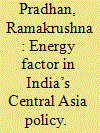

|
|
|
|
|
| Summary/Abstract |
India’s broader foreign policy benefits its energy outreach policies and particularly from the overseas investments of its national companies. From the energy outreach point by going with the maxim of C. Raja Mohan India’s foreign policy strategy divides the world into three concentric circles – immediate neighbourhood, extended neighbour and global stage. Energy interests of India helped her to promote her interests in each of these circles. The benefits of India are particularly clear in the Persian Gulf, Russia and Africa. At the Central Asian front India has a tag of late comer and slow starter. It seems a quite disinterested power in the region. Its disparate policies need reform and strategies need reintegration with the backing of economic muscle and political willpower if India wants to play a decisive role in the region. The July, 2015 visit of Indian Prime Minister Mr. Modi is a positive step in this direction. During this visit New Delhi has signed several bilateral energy agreements with the Central Asian Republics and has paved a way forward for positive engagement with both the regions.
|
|
|
|
|
|
|
|
|
|
|
|
|
|
|
|
| 4 |
ID:
168057


|
|
|
|
|
| Summary/Abstract |
Ramakrushna Pradhan focuses on India’s initiatives and plans to achieve energy security through equity oil and gas and reviews the strategic Central Asian option for supplying a large part of India’s needs in fossil fuels. He also points out that New Delhi’s foreign policy has evolved over the years, placing the energy concern at the top of its list of priorities.
|
|
|
|
|
|
|
|
|
|
|
|
|
|
|
|
| 5 |
ID:
118096


|
|
|
| 6 |
ID:
193394


|
|
|
| 7 |
ID:
116028


|
|
|
| 8 |
ID:
154764


|
|
|
|
|
| Summary/Abstract |
India has been playing a constructive role in Afghanistan since the ouster of Taliban in late 2001. India’s policy options in Afghanistan were clear. Afghanistan should be a democratic multicultural state thereby preventing the return of Taliban. It is in interests of the region that Afghanistan should be a country with peace and stability.
|
|
|
|
|
|
|
|
|
|
|
|
|
|
|
|
| 9 |
ID:
193353
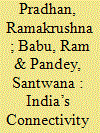

|
|
|
|
|
| Summary/Abstract |
In its renewed engagement with the Central Asian republics in the after math of the Soviet disintegration, the only prominent hindrance that has constrained New Delhi’s direct entry into the heartland region is the geographical barrier. In order to overcome them, India has redesigned its strategies and initiatives under the aegis of Indian Technical and Economic Cooperation.
|
|
|
|
|
|
|
|
|
|
|
|
|
|
|
|
| 10 |
ID:
135491


|
|
|
|
|
| Summary/Abstract |
Development demands growth and growth requires its economic engines to move in right direction. For that, a country requires enormous sources of energy and India as such is not an exception in this case. For India – a welfare state with a national policy committed towards economic growth, rural development, poverty eradication, basic education and adequate health facilities, energy has literally become the life line. Further, the bourgeoning population, modern mode of life style coupled with industrialisation have all together multiplied the energy requirement of India.
|
|
|
|
|
|
|
|
|
|
|
|
|
|
|
|
| 11 |
ID:
136827
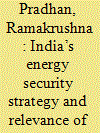

|
|
|
|
|
| Summary/Abstract |
In conclusion, India doesn’t have any country specific policy towards the Central Asian region. It needs to develop that part of its engagement with the region. Additionally, China cannot be ignored while dealing with Central Asia, as it largely factors in the regional trajectory of the region. India needs to include Chinese relevance in its Central Asian policy. India has already price for its in activeness and lack of broad vision in Kashmir, Tibet, Xinjiang, Myanmar and many more. It shouldn’t repeat them again in Central Asia.
|
|
|
|
|
|
|
|
|
|
|
|
|
|
|
|
| 12 |
ID:
156570


|
|
|
|
|
| Summary/Abstract |
One Belt, One Road (OBOR) initiative of China is one of most ambitious foreign and economic policy in recent times which parallels that of the Marshal Plan of post-world war world order. It is the pet project of President Xi Jinping and aims to strengthen Beijing’s economic leadership through a vast program of infrastructure building throughout China’s neighbouring regions.
|
|
|
|
|
|
|
|
|
|
|
|
|
|
|
|
| 13 |
ID:
153153
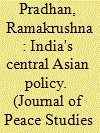

|
|
|
| 14 |
ID:
125318
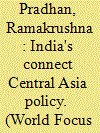

|
|
|
|
|
| Publication |
2013.
|
| Summary/Abstract |
As far as energy sector is concerned, India needs to become a significant player in the equitable exploitation, administration and distribution of the Central Asian energy resources. India must look forward to restart working on TAPI and IPI pipeline projects as they constitute India's energy lifeline. This just wouldn't help India in ensuring her much needed energy security but also enable her in strengthening regional security, peace and cooperation in the region. India must also seek to explore alternative oil and gas transit route along with the existing pipelines. To improve connectivity, India will have to play a pro-active role both bilaterally and through regional cooperative mechanisms.
|
|
|
|
|
|
|
|
|
|
|
|
|
|
|
|
| 15 |
ID:
123379
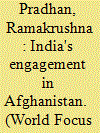

|
|
|
|
|
| Publication |
2013.
|
| Summary/Abstract |
This article is an attempt to study India's engagement in Afghanistan vis-avis other countries and particularly with Pakistan. It also examines New Delhi's interests and involvement in the war ravaged country. It further goes on to discuss the impact of Afghan situation on India's national security both in terms of traditional and energy security purview. The study tries to analyze the implication of growing Indian role in Afghanistan on India-Pakistani and Pakistan-Afghanistani relations. Finally, it briefly argues about the future challenges India will have to face in the wake of the U.S withdrawal from Afghanistan in 2014.
|
|
|
|
|
|
|
|
|
|
|
|
|
|
|
|
| 16 |
ID:
133907


|
|
|
|
|
| Publication |
2014.
|
| Summary/Abstract |
India and Central Asia constitutes strategic neighbours and natural allies. Both the regions are geographically proximate, share common history and cultural affinity. With this premise a modest attempt has been made to know what policies India follow in this region to secure and strive its interests and what more needs to be done. As stated above India requires to open up its diplomatic wings as far as cross border relations are concerned. Look North Policy which was planned long back to give a formal push remained under carpet for too long. There is an immediate and urgent need of this policy to be reactivated if at all India wants to play a big power role in world politics.
|
|
|
|
|
|
|
|
|
|
|
|
|
|
|
|
| 17 |
ID:
131583


|
|
|
|
|
| Publication |
2014.
|
| Summary/Abstract |
The Northeast is geopolitically situated between mainland India and Southeast Asia. As a single geographical entity Northeast of India comprises of seven states - Assam, Nagaland, Manipur, Arunachal Pradesh, Mizoram and Tripura plus Sikkim. The region comprises of highly undulating hilly terrains, covering 263,179 sq km which is about 8% of the total geographical area of the country. The region is one of the landlocked regions of South Asia. About 4500 km i.e. 98% of its border is with five different countries of South Asia-Nepal, Bhutan, China, Myanmar and Bangladesh. No other region of the Indian union share common border with so many different countries. The region is connected to the Indian mainland by a small corridor called 'chicken neck' through the tenuous 22 km Siliguri corridor.
|
|
|
|
|
|
|
|
|
|
|
|
|
|
|
|
| 18 |
ID:
193370


|
|
|
|
|
| Summary/Abstract |
Temples in India are not just places of worship rather a telling saga of India’s rich cultural heritage, scientific and architectural marvel. The Sun temple at Konark is one such engineering marvel located on the bank of river Chandrabhaga facing the endless Bay of Bengal within few metres was constructed during the reign of Narasinghadeva – I of eastern Ganga dynasty in 13th century AD. Also called Black Pagoda of Odisha, this temple is dedicated to Lord Sun. Shaped like a giant chariot, the temple is known for its exquisite stone carvings that cover the entire structure with a an architectural set up of magnets.
|
|
|
|
|
|
|
|
|
|
|
|
|
|
|
|
| 19 |
ID:
185138


|
|
|
|
|
| Summary/Abstract |
Water since 1991 has been at the centre of competition and controversy among the downstream countries (Kazakhstan, Uzbekistan and Turkmenistan) and the upstream countries (Kyrgyzstan and Tajikistan). In recent years, increasing competition for water at an alarming rate only added to an already uneasy tension. While the downstream countries require more water for their agriculture and domestic needs, the impoverished upstream countries are attempting resource nationalism to accrue benefits using the precious waters. In the context of this milieu, this article attempts to examine the connection between resourcefulness and interstate and intrastate conflict in Central Asia and particularly in Kyrgyzstan.
|
|
|
|
|
|
|
|
|
|
|
|
|
|
|
|
| 20 |
ID:
170632
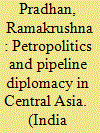

|
|
|
|
|
| Summary/Abstract |
The fight for hegemony in Central Asia has existed for ages. Strategically placed between two nuclear powers—Russia and China—and geopolitically located at the heart of Eurasia, Central Asia has always remained in global limelight. Even after the disintegration of the USSR, the geopolitical importance of Central Asia never waned down, instead emerged as a grand chessboard for regional and extra-regional player for the immense opportunities it has offered in the form of widely untapped natural resources and geostrategic leverages. Importantly, it has emerged as the latest geological landscape for the energy crunch countries as potentially new and non-OPEC source of oil and natural gas. In the quest for energy security and diversity of supply sources by the energy consumers, the heartland region has witnessed a new great game in the scramble for resources. This accentuated struggle for oil and energy in the region has further led to aggressive foreign policy formulations and strategic calculation by countries like the United States, China, European Union, Japan, Israel, Iran, Pakistan and India, to which many now call as the New Great Game for not just controlling but administering the energy resources of the region. The bottom line of the New Great Game unlike the previous version is essentially played out around petropolitics and pipeline diplomacy. It is in this context this research article makes a modest attempt to examine the energy factor in the geopolitics of Central Asia and tries to figure out the position of India in the epic quest for oil in the traditional bastion of Russia and the new grand chessboard of China and the United States.
|
|
|
|
|
|
|
|
|
|
|
|
|
|
|
|